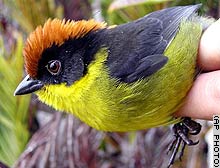New Columbian Bird Species

Considering that in class, we discussed how diverse South American tropical forests are, I found this article quite interesting. Recently, a multicolored bird was discovered high atop the Columbia’s eastern Andean range in the Santander province. This species lives in a Columbian cloud forest, which is only accessible by helicopter. A Columbian-English ProAves Foundation team is responsible for the discovery of this new species. The bird was named the Yariguies Brush-Finch. This fist sized bird is red-crowned with a black back and a yellow underside. The name of this bird came from the Indian tribe that once lived on the natural reserve where it was found.
Columbia is one of the most ecological diverse regions in the world. And the area has around 1,800 know bird species. Blanca Huertas, an expedition member of The Natural History Museum in London said, “ The description of a new bird is a rare event; however, this is just the first of several new species that we will be describing from the Yariguies mountains, including several new butterflies."
To me, this is a great thing. It shows how the world still has its natural beauty. And how places in the world are as they were thousands of years ago, when they remained untouched by humans. I believe that places like this need to be protected, so species like the Yariguies Brush-Finch can continue to live for many years to come. But if the destruction of the world’s rainforests continue, the day will come when almost all of these species will be gone.

1 Comments:
I agree with you. Recently, a major concern has been the extinction of animals that we have not been able to study. Not only is this disallowing us to see and discover these beautiful creatures, but also if you are considering the benefeit of humans, we may be losing animals that could have one day been useful in the study of medicine.
I think we need to slow down and think about what we are doing before we destroy abundant ecosystems such as rainforests. It is very unfortunate that thinking of our 'temporary' benefeit by destroying these ecosystems, we could be eliminating species of animals or plants that could contain a cure for a major disease. Apparently, we are not thinking as far into the future as we need to.
Post a Comment
<< Home